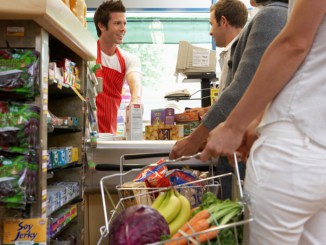
With approximately 300 food co-ops in the U.S. today, cooperative grocers represent fewer than 1 percent of American grocery stores. But food co-ops — which are owned and directed by customers rather than corporations — are holding their own.
Despite an image associating co-ops with back-to-nature, collectivist sensibilities of the 1970s, American food cooperatives actually were born of the Great Depression. Consumers had little cash and many local groceries were shuttered, leaving communities with limited access to fresh food. Families pooled resources in order to buy in volume, direct from wholesalers. By the end of the 1930s, there were approximately 600 well-organized food cooperatives across the country.
In the 1940s and 1950s, as a rebounding economy coincided with a seismic shift in the retail food industry, the first self-service grocery stores (antecedents of today’s supermarkets) brought lower prices and a bigger selection. Nearly all of the original Depression-era co-ops went the way of the Model T and disappeared.
In the 1970s, a new co-op movement took shape — this one fueled more by idealism than necessity. Organic farming, vegetarian diets and communal living were hip, and conventional grocery stores were suddenly out of sync. For a generation looking to buck the establishment, food cooperatives offered a way to practice communitarian ideals and fuel alternative lifestyles, and the number of food co-ops swelled again to about 500 nationwide.
Throughout the 1980s, well-capitalized grocery chains specializing in local and organic foods sprouted like mushrooms. And as vegetarian and organic options became increasingly available, cheaper and more slickly merchandized, the need for food co-ops once again seemed less relevant. By the end of the millennium, half of the second-wave co-ops had closed their doors.
Today, food co-ops once again are on the rise in numbers and revenues. This latest growth spurt appears to be fed by a number of cultural forces. “The notion that diet is a primary driver of health and wellness has become truly mainstream,” says C.E. Pugh, chief operating officer of the National Cooperative Grocers Association. More shoppers are shunning highly processed, industrial foods in favor of products that are (or at least seem) more wholesome, while today’s “conscious consumer” wants to know where and how their food is produced. Many even are willing to spend a bit more in order to support the environment, animal welfare and small local farmers while keeping dollars within the community.
“There is a growing thirst among consumers to vote with their dollar and to buy from places where business is being done fairly,” says Dan Nordley, executive director of the Cooperative Grocers Network.
Operating at the intersection of such interests are co-ops. However, these are not your grandmother’s (or her grandmother’s) food cooperatives. The worker/member model, in which every member spent a few hours a month bagging bulk raisins or operating the cash register to contribute to the cause, has all but disappeared — along with bi-level pricing for members and nonmembers and unwieldy efforts to manage by committee.
Although members still may vote on organizational policies, day-to-day operations are overseen by professional managers (often, veterans of the for-profit grocery industry) who supervise paid employees. Stores are well-lit and feature eye-catching displays, modern technology and expanded inventories. And in addition to organic produce, soy burgers, bulk grains and natural cleaning solutions, you’re likely to find a robust selection of meats, conventional produce, convenience foods and packaged goods. Don’t be surprised to see circulars and coupons, either.
But while co-ops have come to look much more like the conventional grocery stores, their tenets remain constant. All cooperatives operate under seven core principles, which state that members will decide how the co-op will operate and that any operating surplus will be shared by members. A commitment to sustainable community development is another core principle, as is a commitment to education of members and the public.
Some of these principles are costly. Compared to commercial grocers, co-ops have a higher percentage of full-time employees, a higher average hourly wage for part-time staff and more generous benefits packages. Money that could be spent on advertising and marketing may instead be spent on educational programming and outreach. And buying from small farmers and local vendors may support the community, but it often costs more than buying from mainline wholesalers.
Although they work hard to keep prices competitive, co-ops likely never will be the cheapest place to buy food. At their heart, co-ops are value-driven, not profit-driven — and success is not calculated solely in dollars and cents. “We measure many bottom lines,” says Mary Saucier Choate, MS, RDN, food and nutrition educator for the Co-Op Food Stores of New Hampshire and Vermont. “Not just the financial one, but also things like quality of life for our workers, education of our members and sustainability of our buying practices.”
As food co-ops ride this third wave of growth, those within the movement (many of whom are veterans of the second wave’s boom and bust) are thinking hard about how to avoid a third colony collapse. “In the last couple of years, the competitive landscape has changed dramatically, in a way that’s putting pressure on food co-ops,” says Pugh. “Investors are buying up and consolidating the remaining independent natural grocers. And although their early efforts to enter the natural and organic market were haphazard and ineffective, the big industry players have now gotten serious about it, expanding their offerings and launching generic organic labels. We’ll have to become more efficient and productive in order to compete.”
However, co-ops are also becoming more organized, forming coalitions such as the Cooperative Grocers Network and the National Cooperative Grocers’ Association. These meta-cooperatives allow individual co-ops to support and learn from each other, share resources and best practices and negotiate better prices from vendors while preserving their autonomy. Teaming up to get better prices from suppliers is part of that, as is sharing educational materials and operational procedures. “But the primary thing co-ops offer is local ownership and cooperative structure,” Pugh points out. “Our success doesn’t benefit investors; it goes back to the members and the community. That’s always had value and resonance — and that won’t change.”
Monica Reinagel, MS, LD/N, CNS, is the author of Nutrition Diva's Secrets for a Healthy Diet: What to Eat, What to Avoid, and What to Stop Worrying About (St. Martin's Griffin 2011).







